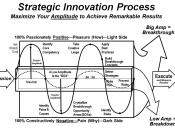(a)Explain how the four main schools of thought: serendipity, linear models, simultaneous coupling model and interactive model, have contributed to our understanding of managing innovation within organisations. (30%)What is innovation in organizations ?Innovation, though used very widely, means different things to different persons/bodies. There are as many definitions as there are authors. However, the definitions of innovation differ in two major ways. The first difference relates to what constitutes innovation and the second relates to the focus of the definition. (Sahay A, 2005 : 66).
Through these varieties of viewpoints, creativity is typically seen as the basis for innovation, and innovation is the successful implementation of creative ideas within an organization.
We focus our definition of innovation as a management process :-Innovation is the management of all the activities involved in the process of idea generation, technology development, manufacturing and marketing of a new (or improved) product or manufacturing process or equipment.
(Trott P, 2005 :15)In the organizational context, innovation may be linked to performance and growth through improvements in efficiency, productivity, quality, competitive positioning, market shares, etc. (University of South Africa, 2009)Models of InnovationSince the 1950s, there has been a proliferation of innovation models, each purporting to explain and/or guide the process of innovation within industrial firms. (Hobday, 2005 : 122).
Strengths and benefits of Innovation ModelsOn the positive side, each generation of model captured the academic knowledge of the time and summarized perceptions of best practice. Each generation served as a foundation for more sophisticated models allowing the incorporation of additional factors relevant to the innovation process. Also each model generated useful insights and hypotheses into the nature of innovation and decision making requirements at the level of the firm, pointing toimportant links between innovation and other key processes within the firm (e.g. management, marketing and...


